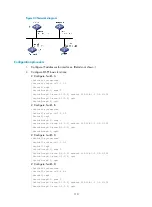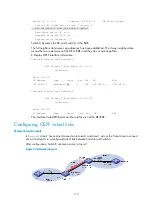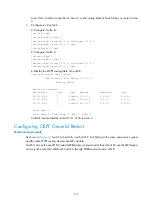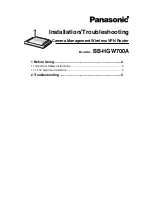
120
[SwitchA] ospf 1
[SwitchA-ospf-1] filter-policy 2000 import
[SwitchA-ospf-1] quit
# Display the OSPF routing table of Switch A.
[SwitchA] display ip routing-table
Routing Tables: Public
Destinations : 10 Routes : 10
Destination/Mask Proto Pre Cost NextHop Interface
3.1.1.0/24 O_ASE 150 1 10.2.1.2 Vlan200
3.1.2.0/24 O_ASE 150 1 10.2.1.2 Vlan200
10.1.1.0/24 Direct 0 0 10.1.1.1 Vlan100
10.1.1.1/32 Direct 0 0 127.0.0.1 InLoop0
10.2.1.0/24 Direct 0 0 10.2.1.1 Vlan200
10.2.1.1/32 Direct 0 0 127.0.0.1 InLoop0
10.3.1.0/24 OSPF 10 4 10.1.1.2 Vlan100
10.4.1.0/24 OSPF 10 13 10.2.1.2 Vlan200
127.0.0.0/8 Direct 0 0 127.0.0.1 InLoop0
127.0.0.1/32 Direct 0 0 127.0.0.1 InLoop0
The route destined for 10.5.1.0/24 is filtered out.
Configuring OSPF FRR
Network requirements
Switch S, Switch A, and Switch D belong to the same OSPF domain as illustrated in
. Configure
OSPF FRR so that when the link between Switch S and Switch D fails, traffic can be switched to Link B
immediately.
Figure 47
Network diagram
Configuration procedure
1.
Configure IP addresses and subnet masks for interfaces on the switches. (Details not shown.)
2.
Configure OSPF on the switches to make sure Switch S, Switch A, and Switch D can communicate
with each other at Layer 3. (Details not shown.)
3.
Configure OSPF FRR:
You can enable OSPF FRR to either automatically calculate a backup next hop, or to designate a
backup next hop by using a routing policy.
(Method I.) Enable OSPF FRR to automatically calculate the backup next hop.
















































